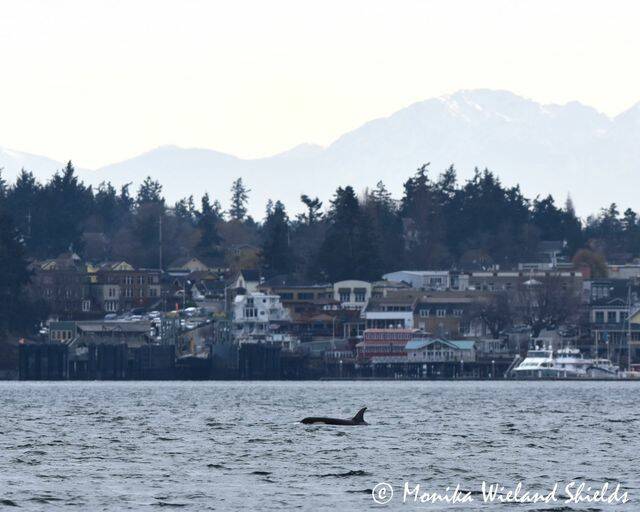Familiar blubbery black and white sea creatures decided to take a jaunt over to San Juan Island last week. J-pod was seen swimming around the bay in Friday Harbor before heading south down San Juan Channel. The pod also welcomed a new calf this week J59 who was born to J37. This marked the first time the pod had been seen together since the initial birth documentation.
Monika Shields, director at Orca Behavior Institute, saw the whales first-hand. “J53 Kiki, who as a six and a half-year-old female is a key individual representing the future reproductive potential of the endangered Southern Residents,” she said.
J-pod has continued to consist of more males than females, so the health of these female orcas is critical for the endangered species.
The sex of the new calf is not yet confirmed. This is her second living offspring, with the son of J49 who is about 10 years old now.
“She was definitely past due to have another calf,” Shields said, with most whales having offspring once every five years.
J37 was one of three pregnant whales that were identified in the fall of 2021. She was the only one who carried out a successful birth.
The Orca Behavior Institute determined this through the non-profit’s drone photogrammetry team. The research group can assess body condition from the air with a drone, so it can determine if a female is heavily pregnant. It can also assess when pregnant whales have lost their calves because their body has reduced, suggesting that there was a miscarriage.
According to a recent study done by the University of Washington, only 33% of orcas have successful births. These miscarriages are largely caused by stress, which can come from boating, commercial shipping, pollution, and lack of food.
Kiki was just four years old when her mother died. There was concern following her death as to whether or not Kiki would survive. Whales that lose their mom at two years or younger have a very low chance of survival because they are still nursing at that time. By the time the whales are three or four years old, they most likely are eating entirely solid food. To survive, the whales must either know how to hunt on their own or have siblings, aunts, or uncles that will prey share with them.
“That can be a lot or a young whale because they’re really dependent on their moms, especially for prey sharing and stuff like that,” Shields said.
During Kiki’s most recent visit, she looked to be in good health, but small. According to Shields, her supportive family plays a large role in keeping calves like Kiki in good condition.
Current members of Jpod include J16 Slick, J17 Princess Angeline, J19 Shachi, J22 Oreo, J26 Mike, J27 Blackberry, J31 Tsuchi, J35 Tahlequah, J36 Alki, J37 Hy’Shqa, J38 Cookie, J39 Mako, J40 Suttles, J41 Eclipse, J42 Echo, J44 Moby, J45 Se-Yi’Chn, J46 Star, J47 Notch, J49 T’ilem I’nges, J50 Scarlet, and J51 Nova.
Kiki’s small size might impact her overall health in the future, Shields said, but researchers have also noticed that orcas have been decreasing in weight overall due to less prey being available. Small size is a concern when it comes to pregnancy, as this is also a factor that can cause pregnancy complications.
Another member of her pod, J56 Tofino, was identified as one of concern as she was very lean. Most recently, she appears to be healthy and active with lots of breaching- which she tends to do a lot.
She said that all of the Southern Resident’s patterns have changed, mostly due to a lack of food. In the summer, she and her team will do more research on both births and deaths to get a better handle on how the whales are doing.
“The whales are such a key indicator species for the health of a big part of the Salish Sea ecosystem, not to mention a beloved icon of the San Juan Islands and Pacific Northwest,” Shields said. “It’s so important to do what we can to protect them as our neighbors and promote their long-term health and well-being.”



